AND EFFECTIVE WAYS TO ADDRESS THEM BOTH …
In the aftermath of the deadly tragedies in El Paso, Texas and Dayton, Ohio, where 31 Americans were killed and 53 wounded at the hands of two sick and evil men, FH will respectfully attempt to bring some perspective to the phenomena of mass shootings and offer our thoughts on the most effective ways to prevent them.
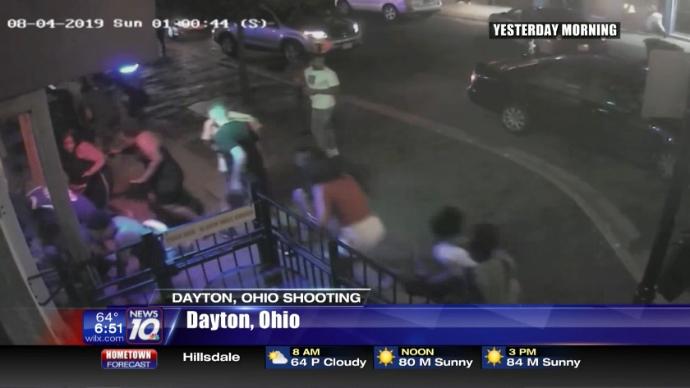
The FBI defines a “mass shooting” as someone who “kills four or more people in a single incident (not including himself), typically in a single, public location.”
Using this definition, Mother Jones developed a database of all mass shootings that have taken place in the United States since 1982. We will use this database (included as a pdf document at the end of this post) to provide our readers with enlightening visuals in the charts below.
From 1982 through the two tragedies noted above, there have been a total of 114 mass shootings resulting in 934 dead and 1,406 wounded. The number of mass shootings and fatalities has been steadily rising in the past two decades.
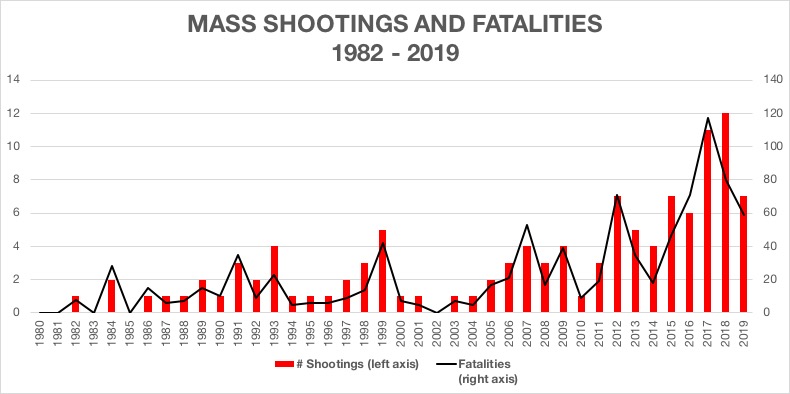
Mass shootings deservedly warrant wall-to-wall news coverage, as they are the personification of evil and a massive jolt to our consciences. While abhorrent, we can’t turn away. We need to understand why to process the unthinkable and rationalize its existence. But even though these atrocities have been occurring more often lately, they are still relatively rare and not nearly as dangerous to the average citizen as other causes of death.
In the past two decades, mass shootings accounted for an average of only 0.2% of all homicides in the United States. Even in 2017, the worst year for mass shootings, they accounted for only 0.68%. Every life is precious and should be protected, but it is also important to maintain perspective when determining how much nationally priority and resources should be devoted to stopping these relatively rare occurrences and how much the government should infringe on the privacy and rights of law-abiding citizens.
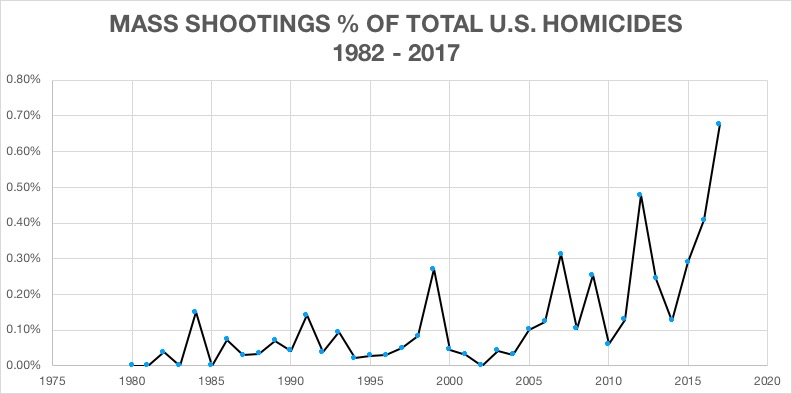
According to the U.S. Department of Health and Human Services (CDC), there were 2,813,503 deaths in the U.S. in 2017, including 117 deaths due to mass shootings. But those mass shooting deaths accounted for only 0.004% of all deaths in the U.S.
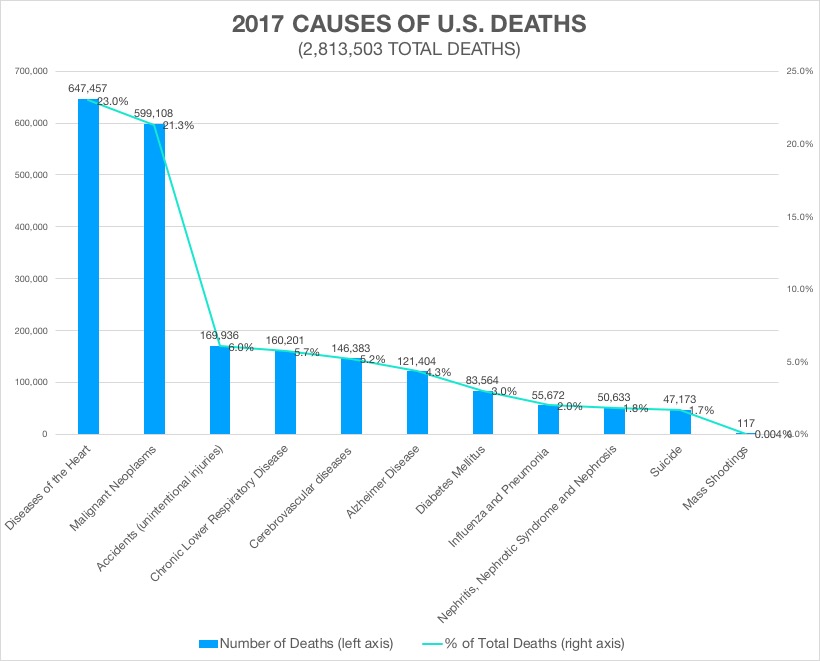
There were 5,738 homicides in the nation’s 50 biggest cities in 2017, compared with 117 mass shooting homicides in the entire U.S. In fact, there were less than half as many mass shooting deaths in the entire U.S. than there murders in any one of the top five U.S. cities. If you were a black inner city resident in one of those five cities, which crisis would you want the government to prioritize in finding a solution?
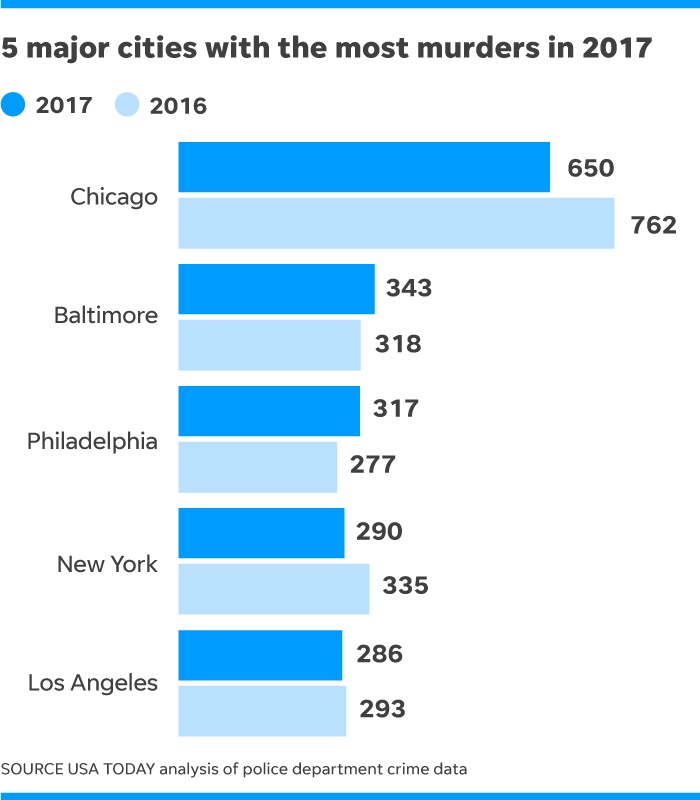
Now we will provide some perspective on the type of person responsible for mass shootings in the U.S. The national media and Hollywood regularly portray mass shooters as young white males. While there’s no doubt that mass shooters are usually male (only 4 of 114 or 3.5% of events in the 1982 – 2019 timeframe involved females), let’s take a closer look at the facts on age and race.
The scatter chart below plots mass shooter age against 114 shooting events in temporal order (from left-to-right, 1982 – 2019). Our observations and comments:
- The median age of mass shooters is 34-years-old, but there is a very wide range of ages — from 11- to 64-years-old.
- The median age has been slightly declining over the past four decades, but still within the historical 30 – 40-years-old range.
- Only 14 of 114 or 12% of shooters were below the age of 21 when they were involved in a mass shooting. So, yes, raising the age requirement for purchasing a gun to 21-years-old might stop 12% of potential mass shooters, but legislators will have to weigh the benefits of thwarting that extremely small number of bad guys versus postponing the rights of thousands of mentally-healthy, law-abiding youth who simply want to hunt or shoot for sport with their fathers.
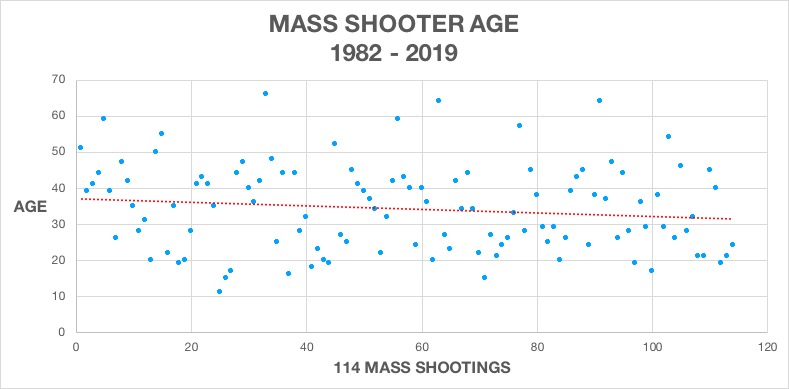
The chart below identifies the race of all mass shooters from 1982 to present day. Unsurprisingly, the mass shooters’ race resembles the actual racial distribution in America, with Whites and Latinos slightly under-represented (good) and Blacks, Asians and Native Americans slightly over-represented (bad).
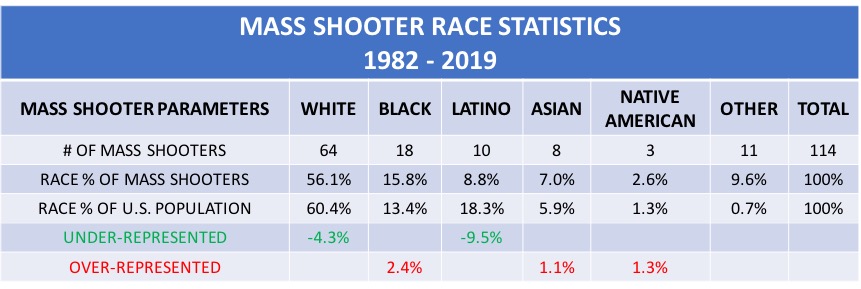
We now turn to the types of locations where shootings have taken place.
According to the Crime Prevention Research Center, 94% of mass shootings over the past 70 years have occurred in gun-free zones. Isn’t the lesson obvious? The only thing that stops a bad guy with a gun is a good guy with a gun. Dayton, Ohio police officers bravely killed the most recent mass shooter in only 32 seconds after he began firing, yet the shooter was still able to kill 22 people. What if there was a civilian with a carry permit and concealed weapon right on the scene who could have responded even faster? How many more lives could have been saved?
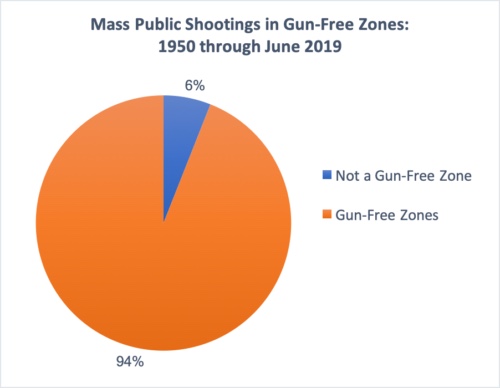
While shootings at Sandy Hook Elementary and Columbine and Marjory Stoneman Douglas High Schools were sickening, frightening, and a parent’s and student’s worst nightmare, mass shootings in schools are relatively rare, accounting for 17 events or 15% of all mass shootings over the past four decades. Thankfully, cities have recently been hardening their schools with practical solutions, like secure entrances, security guards and armed teachers, that should form a much better deterrent to cowards who previously strolled into insecure gun-free-zones to do their dastardly deeds.
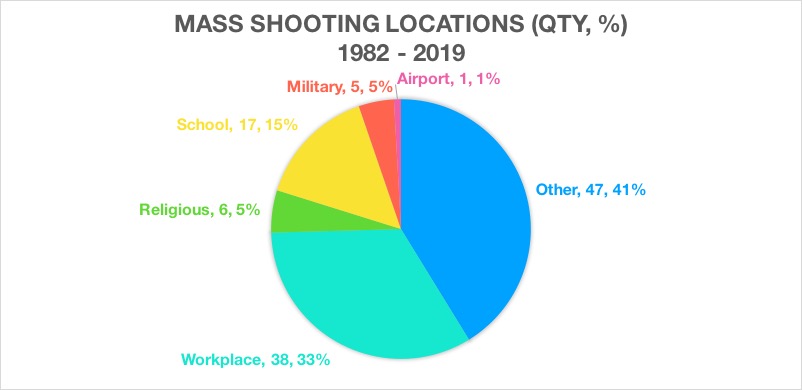
Lastly, we want to provide our perspective on the guns used in mass shootings.
Over half of mass shootings involved a handgun and under a third involved rifles, typically of the semiautomatic variety (meaning, one shot fired per trigger pull).
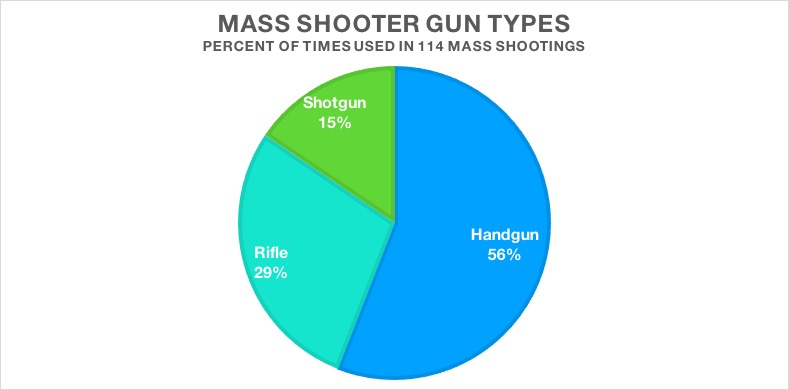
Roughly 75% of the guns used in mass shootings were purchased legally. This tells us that our current background check system is inadequate, as it’s not keeping guns out of the hands of people who should not have them.
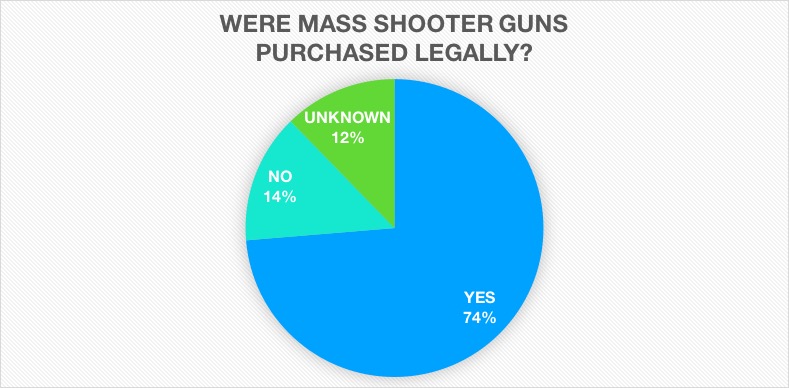
So now that you have a high quality perspective on this important issue, what are FH’s recommendations for preventing future mass shootings? Glad you asked …
KEEP THINGS IN PERSPECTIVE. Let’s do everything we can to address the scourge of mass shootings, but let’s keep the scale of the problem in perspective when devising solutions that might infringe on the rights of law abiding citizens.
PRIMARY FOCUS SHOULD BE ON PEOPLE, NOT GUNS. People pull the trigger, guns don’t fire themselves. Let’s produce better background checks that prevent bad people from getting guns and limit the hassle for good people trying to obtain them legally. Stopping the expungement of elementary and high school records, as well as armed forces records, would provide a more complete picture of the young person trying to purchase a deadly weapon. And we think it’s time to reestablish involuntary commitment of the mentally ill to humane confinement and rehabilitation. Finally, we are not trained psychiatrists, but both government and private psychiatric experts need to discover why men are committing these horrible crimes. We wouldn’t be surprised to learn there are high causal correlations between a mass shooters’ psychosis and jihad recruitment background factors like abusive, fatherless and/or faithless families, female rejection, social ostracization, mass murder fascination, first-shooter video games, and extreme internet groups.
ENACT EFFECTIVE GUN CONTROL LEGISLATION.
Here are gun control proposals we oppose and why:
- Universal Background Checks – We already have universal background checks and we’ve shown above that they don’t stop 75% of mass shooters who purchased their weapons legally.
- Background Checks for Private and Online Gun Sales – Ditto the above answer. Most mass shooters buy their guns legally from a retail store or get them from family.
- Mandatory Gun Buybacks – These rarely work, as the good guys return their guns and the bad guys keep theirs.
- Assault Weapon Ban – For starters, it’s unrealistic. The National Shooting Sports Foundation has estimated that approximately 5 million to 10 million AR-15 style rifles exist in the U.S., within the broader total of 300 million firearms owned by Americans. And besides, the black assault rifle is simply a nastier “looking” version of the standard hunting rifle, both of which are semi-automatic.
- Raising Gun Buying Age to 21 – As we’ve shown above, this won’t thwart the majority of potential mass shooters who are 21 or older.
Here are gun control proposals we support and why:
- Ban High Capacity Magazines – Ask anyone who’s ever been in a real gunfight and they’ll tell you that it’s usually over in seconds. Real world defensive situations rarely require a rifle or handgun to have a high capacity magazine with more than 10 rounds. On the other hand, for a mass shooter entering a gun free zone, where the likelihood of someone shooting back at you before firing off tens of rounds is nil, a high capacity magazine maximizes the number of shots one can fire before reloading. The Dayton, Ohio mass shooter used a 100-round magazine. We support banning magazines with capacity greater than 10 rounds.
- Require ATF Form 4 Approval for All Pistol Rifle Purchases – The Dayton, Ohio mass shooter used a pistol rifle and ammo drum magazine like the one pictured below. This weapon is very short like a pistol but fires the same powerful ammo as a rifle. A very concealable rifle like this used to be banned, but manufacturers avoided illegality by replacing the fixed stock with a telescopic forearm brace. Congress must pass legislation requiring ATF approval of a Form 4 application (which involves a 9-month long, extensive background check and fingerprinting) for legal purchase of such pistol rifles.
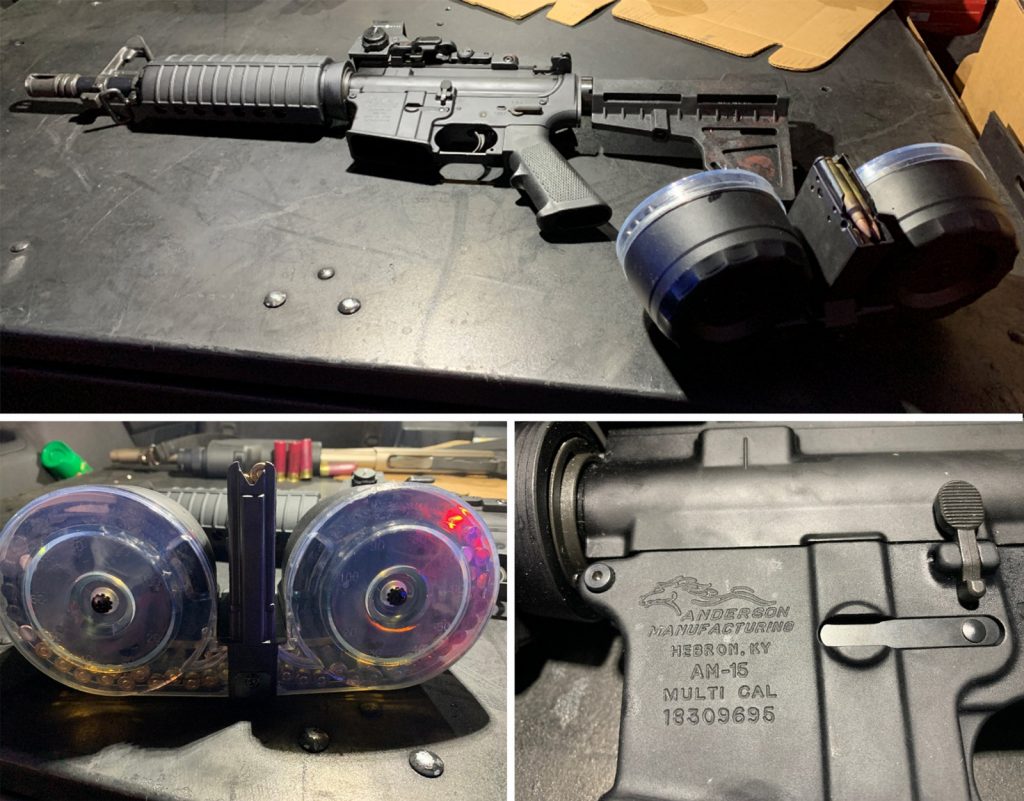
Courtesy of Dayton Police Department
Source: NPR
Here are gun control proposals we may support and why:
- Red Flag Laws – Beware the slippery slope of red-flag laws that “predict” future illegal behavior based on past legal speech or actions to justify the confiscation of your guns. Has anyone seen the 2002 Tom Cruise movie, Minority Report? These laws could also set a dangerous precedent for confiscating other assets or restricting other rights based on speech the government doesn’t like. However, we may support such laws if the federal government sets up universal terms that include rigorous due process protections. Meanwhile, we will withhold our support until we see the terms and due process rights in writing.
ATTACHMENT: US Mass Shootings, 1982-2019: Data From Mother Jones’ Investigation
MS-Mother-Jones-Mass-Shootings-Database-1982-2019-Sheet1